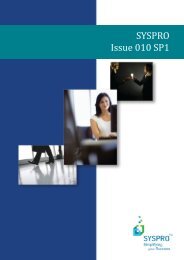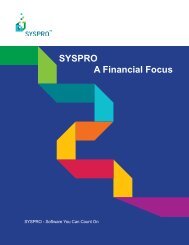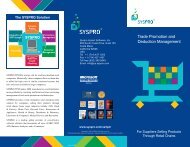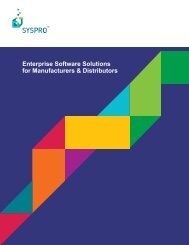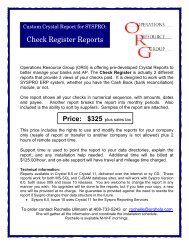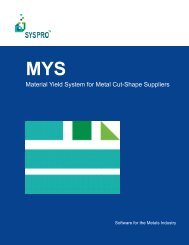Teach Yourself e.net - Syspro
Teach Yourself e.net - Syspro
Teach Yourself e.net - Syspro
Create successful ePaper yourself
Turn your PDF publications into a flip-book with our unique Google optimized e-Paper software.
3<br />
Getting Started with e.<strong>net</strong> solutions<br />
Objectives - In this chapter we will introduce the basic structure of programming with<br />
e.<strong>net</strong> solutions. We will demonstrate the capabilities of programs that interact with the<br />
e.<strong>net</strong> solutions framework by using two different models: the Basic model, and the<br />
Abstraction Model. By the end of this chapter you will have created your first program,<br />
sending and receiving information from the SYSPRO application server through the e.<strong>net</strong><br />
solutions framework.<br />
3.1. The Structure of Program<br />
Having seen what SYSPRO e.<strong>net</strong> solutions is comprised of, and how SYSPRO is<br />
accessible to COM and .NET programming through e.<strong>net</strong> solutions, we now turn our<br />
attention to the concepts of programming that will access the e.<strong>net</strong> solutions framework.<br />
Development of e.<strong>net</strong> solutions based applications requires the programmer or<br />
development team to consider questions of programming organization and structure. As<br />
we consider programming with e.<strong>net</strong> solutions, there are two development models that we<br />
can use to define our development methods and application structure:<br />
• The Basic Model<br />
• The Abstraction Model<br />
3.1.1. The Basic Model<br />
The Basic Model is centered around the e.<strong>net</strong> solutions COM interface. As such it requires<br />
that an application will, for each interaction with SYSPRO, call a method, a business<br />
object if required, and pass/receive parameters or data as XML strings. The Basic Model,<br />
while simple, enables rapid development of rich and fully functional applications.<br />
Understanding of the Basic Model provides the foundation for developers that wish to<br />
structure their application using the The Abstraction Model.<br />
As with any application development, developers need to have a clear understanding of<br />
their business's or customer's requirements in order to design an application that will<br />
provide the required functionality. If this objective is clear, the basic structuring and<br />
functionality of an e.<strong>net</strong> solutions application is easily described using Unified Modeling<br />
Language (UML) Sequence-Diagramming.<br />
The application shown in Figure 3.1, “Basic Program Structure” [3–3] illustrates the use<br />
of the e.<strong>net</strong> solutions framework and business object components to create an application



